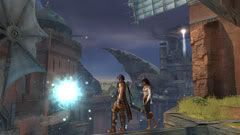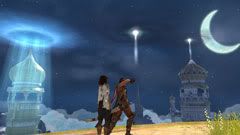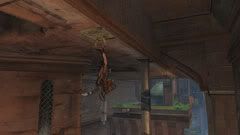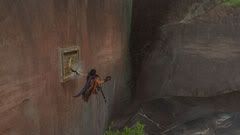
The 3D portion of the Prince of Persia franchise has had an interesting history. There was, of course, the long-forgotten Prince of Persia 3D that was made during the "take old games and make them 3D" craze, but even the angriest of video game nerds have forgiven and forgotten. That's largely because the next attempt, Prince of Persia: The Sands of Time, came many years later and was many magnitudes better. It had great level design and an innovative time reversal system helped alleviate the frustration that often comes with tricky 3D jumping. Although other 3D platformers would obviously have a hard time incorporating a similar system for storyline reasons, many (including the Italian plumber himself) imitated its iconic wall-jumping and pole-swinging mechanics. On top of that, it had gorgeous stylized graphics and pretty good characters.
But as almost anyone who's played the game will tell you, its combat sections were rarely rewarding and often frustrating, due to a combination of clumsy controls and repetitiveness. This was rectified in Prince of Persia: Warrior Within, which had a more enjoyable combat system while keeping pretty much all of the great platforming intact. Unfortunately, the game's "hardcore" makeover repulsed more fans than it attracted. So in Prince of Persia: The Two Thrones, Ubisoft toned down the blood 'n boobs but added a questionable "speed kill" system, which I felt required a frustratingly high level of precision. Speed kills were also tied to long animated sequences, which meant you often couldn't rewind time far enough to correct your mistakes.
So there's a bit of a pattern here (which I'm far from the first to point out, Yahtzee). The POP games have a habit of getting a whole lot of things right, but then also getting a few key things wrong that keep them from achieving true greatness. And often, those key things have to do with the balance between platforming and combat; the former is almost always the best part of the game, with the latter feeling like they had trouble fitting it in. The games have also had some issues with production values; while they all looked gorgeous, they fell prey to various audio glitches, cutscene sloppiness, and even a few rare game-breaking bugs. If I had to pick one as the best representation of the series, I would actually go with Warrior Within, since most of its bad decisions were only skin-deep. It plays the best out of the three games, and a good chunk of it is actually quite aesthetically pleasing, even though everything bleeds and wears thongs all of a sudden.
Anyway, that's all in the past, because the Sands of Time trilogy has (wisely) been put to rest so Ubisoft can try its hand at another reimagining of the franchise -- and the genre. Prince of Persia 2008, as I will be calling it from now on, builds off of some ideas from Ubisoft's Assassin's Creed. It employs an "open world" design philosophy, a streamlined running & jumping system, and a "marionette" control scheme where each of the four buttons corresponds to a body part, each with various context-sensitive functions. Unlike in most platformers before it, buttons don't need to be held down for things such as climbing onto ledges and running on walls, which definitely takes some getting used to. Like The Sands of Time, it has the potential to influence a new generation of platformers, but also like The Sands of Time, it has flaws. And they're a bit harder to ignore this time around.
Here are the basics: you run around a large world aided by your magical female companion, Elika. Your job is to rid the world of corruption, which isn't as hard as it sounds, since "corruption" in this case means black goo that occasionally turns into enemies. If you fall into goo or a deep pit, Elika floats over and pulls you back to safety, which usually means the beginning of a certain series of jumps. Most of the game is spent jumping between platforms, ledges, and grabby-rings. This is broken up by the occasional puzzle or battle. Combat is always one-on-one, and it involves creating combos by chaining together four different types of attacks (controlled by the four context-sensitive buttons). If you get "defeated" during combat, Elika saves you from actual death and you continue fighting, but the enemy regains a significant amount of health.
I basically like the idea behind this combat system. Enemies don't get in your way when you're trying to progress through the level and they can't knock you off platforms. The fact that you can't technically get killed in battle seems like a cop-out at first, but it actually makes quite a bit of sense. Since this game (and most games like it) won't allow the story to progress until the main character wins the battle, allowing you to die only to reload and try again is essentially a waste of time. Having Elika "rescue" you for a non-fatal penalty dispenses with the shallow illusion that your character's loss actually has any effect on the story.
The combo system is fun -- sometimes. Unfortunately, your freedom to create combos is largely inhibited by the enemies' constant blocking, as well as some other pretty arbitrary restrictions. In an effort to make the combat difficult, they seem to have removed a lot of the fun from it. Consequently, the most enjoyable combat comes when you fight what I would consider to be the "easiest" boss, since he doesn't block everything you try to do. You can actually choose when you want to fight each boss; there are many different branching paths through the game. But does it really matter? Despite the subtle variation in boss difficulty (which is either unintentional or doesn't make sense), every area feels basically the same. And that brings me to the game's biggest problem.
For a while, it was hard for me to pin down exactly what made the game world seem so uniform. As far as "open worlds" go, it's not quite as much of a cut-and-paste job as Oblivion, and there's nothing wrong with having consistent architectural themes; just look at the previous POP games, which take place mostly in broken-down temples. Perhaps, I thought, the game needs more indoor areas to add variety, but that didn't seem quite right either. The game world does have its fair share of landmarks, many of which are stunningly beautiful to look at. But there's the catch: all you're doing is looking at them. Not running around on them, climbing them, or fighting enemies on them. It will eventually dawn on you that you spend a stunningly large amount of time looking at walls in this game, and rarely at all the exotically beautiful stuff right behind you. You're constantly on the outskirts of all these diverse, beautiful environments instead of being in them. You can really never run for more than 5 seconds in this game without having to jump onto something.
So yes, I am saying that there is actually too much jumping in this game. I know that sounds like a stupid criticism for a Prince of Persia game, but it's really hard to design truly memorable levels out of a bunch of floating walls. The franchise's trademark wall-running is just out of control here -- it's pretty much the primary method of travel in this world. And I find myself conflicted, because the gameplay is actually reminiscent of that one part in each Sands of Time game where you'd be scaling the outside of a really high tower, which always felt really awesome, but I guess without the indoor parts it loses its luster. How interesting can outskirts really be? You'll see a whole lot of ledges, vines, and grabby-rings in this game, but for my money, one of the best experiences comes during the breather portions, when you're running across the sandy dunes of the "hub world", shrouded in moonlight.
On that note, let's get one thing straight: the game looks beautiful, even if most of its wonderfully crafted world ends up being window dressing. The production values are the best and most consistent so far in the series, although the voices still get lost in the mix often enough that you'll need to turn subtitles on. The animation is much more fluid than in the previous games, making good use of the Assassin's Creed engine. Everything flows together smoothly, and if Elika ever threatens to get in the player's way, the two characters do a nice little "dance" around each other that's quite endearing. Occasionally the elaborate animations will cause you to misfire a jump, but on the off chance that that does happen, you'll be rescued anyway. The "painterly" style of the game is effective yet subtle, never obtrusive or overly impressed with itself. The soundtrack is absolutely wonderful, mostly revolving around a beautifully orchestrated main theme. The presentation is impressive from the moment you load up the game, and it rarely falters.
POP2008 is a game that tries a lot of new ideas, and when a game that tries new ideas doesn't live up to its potential, those ideas tend to be criticism magnets. I think most of these ideas have actually been implemented really well, though the battle system does have its flaws. The non-dying aspect may give the game the appearance of being too easy, but I don't think it really is. It's actually the age-old conundrum of level design that has snuck up to bite the developers here. The good news is that this game is very likely to get a sequel, so hopefully they focus on correcting the game's core issues and don't do the wildly misguided backpedaling that soured so many people on Warrior Within.










No comments:
Post a Comment